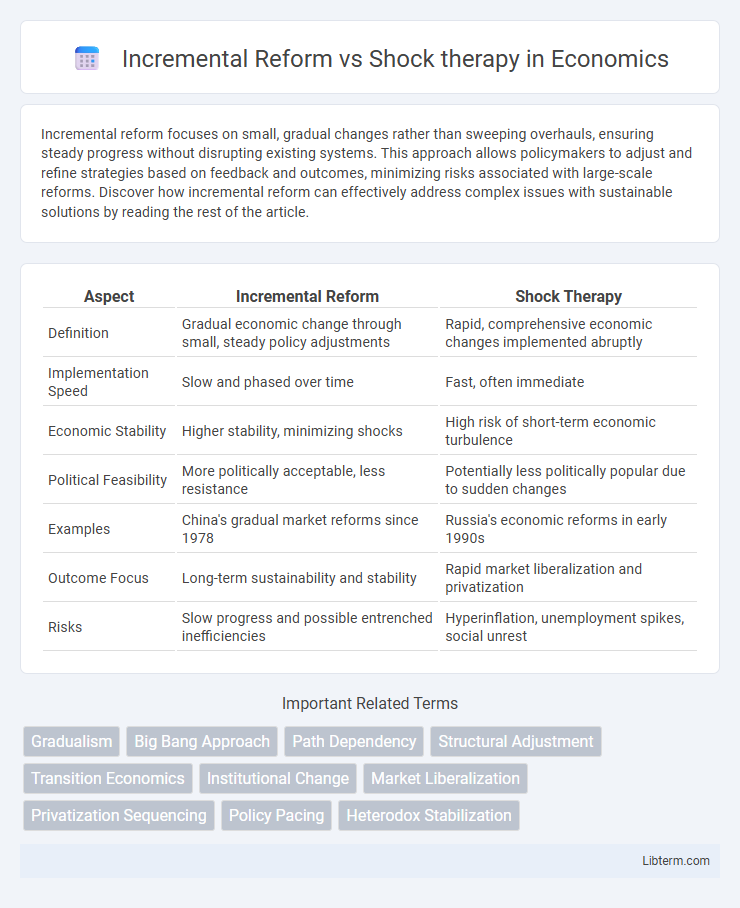Incremental reform focuses on small, gradual changes rather than sweeping overhauls, ensuring steady progress without disrupting existing systems. This approach allows policymakers to adjust and refine strategies based on feedback and outcomes, minimizing risks associated with large-scale reforms. Discover how incremental reform can effectively address complex issues with sustainable solutions by reading the rest of the article.
Table of Comparison
| Aspect | Incremental Reform | Shock Therapy |
|---|---|---|
| Definition | Gradual economic change through small, steady policy adjustments | Rapid, comprehensive economic changes implemented abruptly |
| Implementation Speed | Slow and phased over time | Fast, often immediate |
| Economic Stability | Higher stability, minimizing shocks | High risk of short-term economic turbulence |
| Political Feasibility | More politically acceptable, less resistance | Potentially less politically popular due to sudden changes |
| Examples | China's gradual market reforms since 1978 | Russia's economic reforms in early 1990s |
| Outcome Focus | Long-term sustainability and stability | Rapid market liberalization and privatization |
| Risks | Slow progress and possible entrenched inefficiencies | Hyperinflation, unemployment spikes, social unrest |
Understanding Incremental Reform and Shock Therapy
Incremental reform involves gradual policy changes aimed at stabilizing and improving an economy through step-by-step adjustments, prioritizing social stability and minimizing disruptions. Shock therapy advocates for rapid, radical economic shifts such as immediate market liberalization, privatization, and price deregulation to quickly transition from a planned to a market economy. Understanding these approaches requires analyzing their impacts on economic growth, inflation control, social welfare, and institutional capacity during periods of systemic transformation.
Historical Contexts of Economic Transformation
Incremental reform and shock therapy represent two distinct approaches to economic transformation, with historical contexts shaping their adoption and outcomes. Incremental reform, as seen in China's post-1978 period, emphasizes gradual policy changes and market liberalization to ensure stability and prevent social disruption. In contrast, shock therapy, notably implemented in post-Soviet Russia during the early 1990s, involves rapid privatization and liberalization aimed at quickly transitioning to a market economy, often resulting in economic volatility and social hardship.
Key Principles of Incremental Reform
Incremental reform emphasizes gradual policy changes, allowing time for adjustments and stakeholder feedback to minimize social and economic disruptions. This approach relies on steady progress through small-scale interventions, maintaining institutional stability and reducing risks associated with abrupt transitions. Key principles include flexibility, continuous evaluation, and consensus-building among political and economic actors.
Core Concepts of Shock Therapy
Shock therapy involves rapid and comprehensive economic reforms aimed at quickly transitioning a centrally planned economy to a market-oriented system. Core concepts include immediate liberalization of prices to eliminate shortages, rapid privatization of state-owned enterprises to foster private sector growth, and stabilization policies to control hyperinflation and stabilize the currency. This approach contrasts with incremental reform by prioritizing speed and drastic changes to accelerate economic restructuring and market integration.
Case Studies: Successes and Failures
Incremental reform in China demonstrates success through gradual market liberalization, resulting in sustained economic growth and poverty reduction, while Russia's shock therapy in the 1990s led to hyperinflation, economic contraction, and widespread social hardship. Poland's partial shock therapy combined with strategic reforms achieved rapid stabilization and growth, contrasting with Ukraine's prolonged economic instability due to inconsistent policies. The varying outcomes of these case studies highlight the importance of institutional capacity and social safety nets in implementing economic transitions.
Socioeconomic Impacts of Each Approach
Incremental reform in economic policy tends to promote gradual improvements in socioeconomic conditions by allowing adaptation time for labor markets and social safety nets, reducing the risk of unemployment spikes and social unrest. Shock therapy, characterized by rapid market liberalization and privatization, often leads to short-term economic volatility, increased inequality, and significant social displacement before potential long-term growth benefits materialize. Studies comparing post-Soviet transitions reveal that countries adopting cautious incremental reforms generally experienced more stable income distribution and slower poverty growth than those implementing rapid shock therapy.
Political Challenges and Stakeholder Responses
Incremental reform faces political challenges such as resistance from entrenched interest groups and bureaucratic inertia, leading to slower but more stable transitions favored by stakeholders valuing predictability. Shock therapy provokes swift political backlash due to sudden economic disruptions, eliciting crisis-driven responses from policymakers and polarized reactions from stakeholders who either support rapid liberalization or fear social instability. Stakeholder responses vary, with incremental reform garnering cautious consensus among reform advocates and skeptics, while shock therapy polarizes public opinion and political elites, impacting reform sustainability.
Speed of Change: Gradualism vs Rapid Transition
Incremental reform emphasizes gradualism, implementing policy changes step-by-step to allow institutions and markets to adapt progressively, reducing economic shocks and social disruption. Shock therapy advocates rapid transition through comprehensive reforms, rapidly liberalizing markets and privatizing state assets to quickly establish a market economy, though it risks short-term instability and economic hardship. The speed of change in incremental reform tends to promote stability and sustainability, while shock therapy prioritizes swift transformation at the cost of potential volatility.
Lessons Learned from Global Experiences
Incremental reform allows economies to gradually adapt institutions and legal frameworks, reducing social disruptions and fostering sustainable growth, evidenced by successful transitions in countries like China and Vietnam. In contrast, shock therapy, characterized by rapid liberalization and privatization as seen in Russia during the 1990s, often led to severe economic contractions and social instability due to insufficient institutional readiness. Global experiences highlight that sequencing reforms and building regulatory capacity are critical, with gradual approaches generally yielding more inclusive development outcomes than abrupt policy shifts.
Choosing the Right Path: Factors to Consider
Choosing the right path between incremental reform and shock therapy depends on economic stability, institutional capacity, and social resilience. Incremental reform suits economies with established institutions and gradual market integration, minimizing social disruption. Shock therapy may be necessary for rapidly stabilizing hyperinflation or deep economic crises but risks social unrest without strong governance and safety nets.
Incremental Reform Infographic

 libterm.com
libterm.com